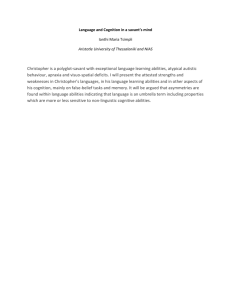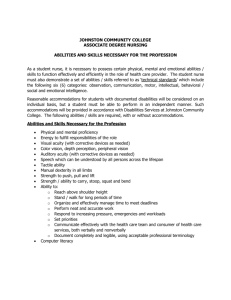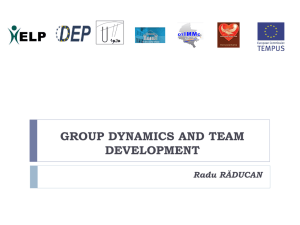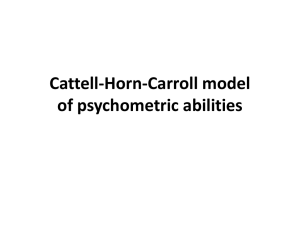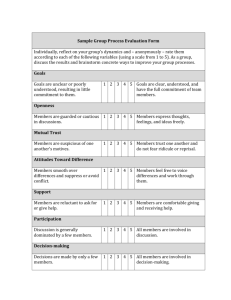I-O Psychology: Individual Differences & Assessment
advertisement
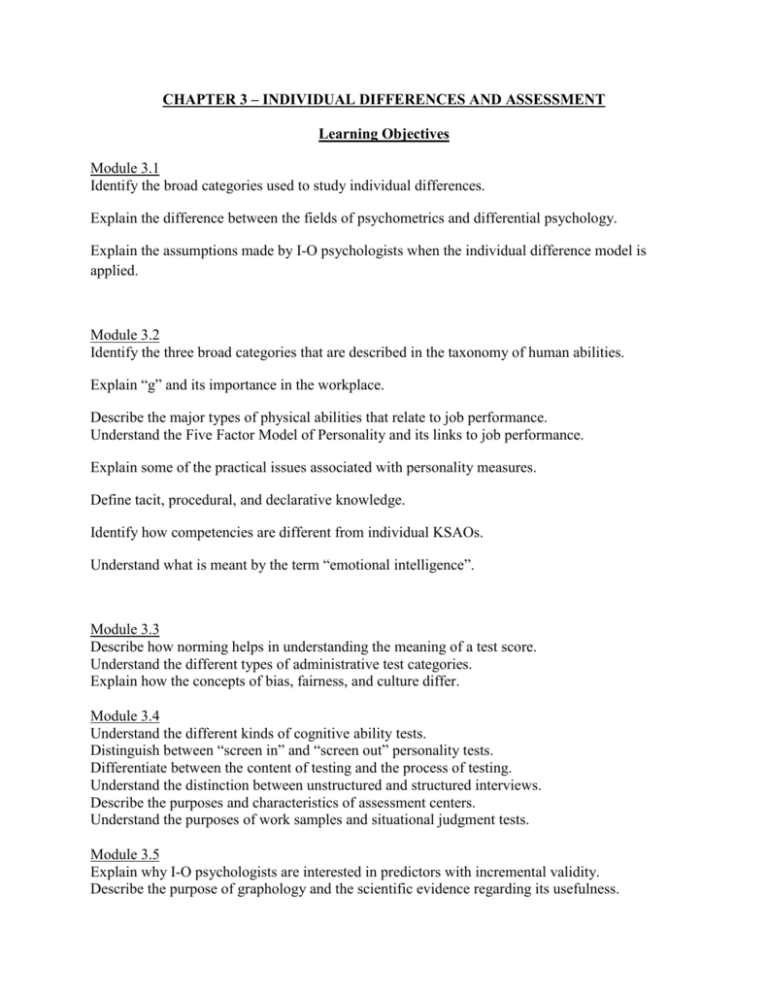
CHAPTER 3 – INDIVIDUAL DIFFERENCES AND ASSESSMENT Learning Objectives Module 3.1 Identify the broad categories used to study individual differences. Explain the difference between the fields of psychometrics and differential psychology. Explain the assumptions made by I-O psychologists when the individual difference model is applied. Module 3.2 Identify the three broad categories that are described in the taxonomy of human abilities. Explain “g” and its importance in the workplace. Describe the major types of physical abilities that relate to job performance. Understand the Five Factor Model of Personality and its links to job performance. Explain some of the practical issues associated with personality measures. Define tacit, procedural, and declarative knowledge. Identify how competencies are different from individual KSAOs. Understand what is meant by the term “emotional intelligence”. Module 3.3 Describe how norming helps in understanding the meaning of a test score. Understand the different types of administrative test categories. Explain how the concepts of bias, fairness, and culture differ. Module 3.4 Understand the different kinds of cognitive ability tests. Distinguish between “screen in” and “screen out” personality tests. Differentiate between the content of testing and the process of testing. Understand the distinction between unstructured and structured interviews. Describe the purposes and characteristics of assessment centers. Understand the purposes of work samples and situational judgment tests. Module 3.5 Explain why I-O psychologists are interested in predictors with incremental validity. Describe the purpose of graphology and the scientific evidence regarding its usefulness. Understand the arguments for and against the use of polygraphs in the workplace. Describe the arguments for and against the use of drug and alcohol testing at work. Identify changes to testing that have been brought about by computer-based assessment. Chapter Outline Module 3.1 An Introduction to Individual Differences Some Background Differential Psychology, Psychometrics, and I-O Psychology Identifying Individual Differences Varieties of Individual Differences Module 3.2 Human Attributes Abilities Cognitive Abilities Intelligence as “g” Is “g” Important at Work? Is “g” as Important in Other Countries as It Is in the United States? Can Your Level of “g” Change? The Issue of Retesting and Cognitive Ability Specific Cognitive Abilities beyond “g” Physical, Sensory, and Psychomotor Abilities Physical Abilities Sensory Abilities Psychomotor Abilities Personality and Work Behavior The Big Five Model of Personality Other Models of Personality Implications of Broad Personality Models Personality Change over the Life Span Additional Attributes Skills Knowledge Competencies Emotional Intelligence Module 3.3 Foundations of Assessment The Past and the Present of Testing What Is a Test? What Is the Meaning of a Test Score? Test Users and Test Interpretation What Is a Test Battery? Where to Find Tests Administrative Test Categories Speed versus Power Tests Group versus Individual Tests Paper and Pencil versus Performance Tests Testing and Culture International Assessment Practices Module 3.4 Assessment Procedures Assessment Content versus Process Assessment Procedures: Content Cognitive Ability Tests Knowledge Tests Tests of Physical Abilities Psychomotor Abilities Personality Practical Issues Associated with Personality Measures Integrity Testing Emotional Intelligence Individual Assessment Interviews Interview Content Interview Process Assessment Centers Work Samples and Situational Tests Work Sample Tests Situational Judgment Tests Module 3.5 Special Topics in Assessment Incremental Validity Biographical Data Grades and Letters of Recommendation Minimum Qualifications Useless Assessment Practices: Graphology and the Polygraph Drug and Alcohol Testing Computer-Based and Internet Assessment Unproctored Internet Testing Who Is a Candidate? Computer Adaptive Testing Testing and Demographic Differences Glossary Terms for Chapter 3 This list of key terms and important concepts from Chapter 3 can be used in conjunction with reviewing the material in the textbook. After reviewing Chapter 3 in the textbook, define each of the following key terms and important concepts fully. Check your answers with the textbook, and review terms with which you have difficulty. Good luck! MODULE 3.1: AN INTRODUCTION TO INDIVIDUAL DIFFERENCES individual differences mental test differential psychology intelligence mental ability metric psychometrics intelligence test psychometrician cognitive ability “g” general mental ability g-ocentric model physical abilities personality interests knowledge emotion MODULE 3.2: HUMAN ATTRIBUTES taxonomy perceptual-motor abilities affect IQ Intelligence Quotient meta-analysis Flynn effect mean standard deviation stamina muscular tension muscular power muscular endurance sensory abilities Americans with Disabilities Act psychomotor abilities sensorimotor abilities motor abilities Big 5 Five Factor Model (FFM) conscientiousness functional personality at work agreeableness emotionally stability integrity achievement dependability skills people skills O*NET tacit knowledge procedural knowledge declarative knowledge competencies job analysis emotional intelligence (EI) construct MODULE 3.3: FOUNDATIONS OF ASSESSMENT mental test test norming norm group test battery speed test power test group test individual test paper and pencil test performance test Mental Measurements Yearbook bias fairness culture MODULE 3.4: ASSESSMENT PROCEDURES cognitive ability test cognitive test battery knowledge test psychomotor abilities screen out test screen in test self-presentation overt integrity test personality-based integrity test emotional intelligence (EI) emotional intelligence quotient (EQ) individual assessment situational interview structured interview unstructured interview assessment center work sample test situational judgment test MODULE 3.5: SPECIAL TOPICS IN ASSESSMENT biodata ecology model incremental validity social desirability Computer Adaptive Testing (CAT) routing test Practice Questions for Chapter 3 Multiple Choice Items: Please choose the correct answer to the following questions. Answers are shown at the end of the chapter in this Study Guide. 1. All of the following are fundamental assumptions that I-O psychologists make when they apply the individual differences model except: a. The attribute levels of various people in a group can be brought to the same level through training. b. Different jobs require different attributes. c. Adults have a variety of attributes, the levels of which remain relatively stable over time. d. The attributes can be measured accurately. 2. Fleishman’s taxonomy of 52 abilities can be divided into the categories of cognitive abilities, perceptual-motor abilities, and a. Problem solving abilities. b. Emotional abilities. c. Performance abilities. d. Physical abilities. 3. Measures of “g” assess all of the following except: a. Knowledge acquisition. b. Perceptual ability. c. Reasoning ability. d. Problem-solving ability. 4. As the complexity of a job ___________, the predictive value of general intelligence tests ___________. a. increases; stays the same. b. increases; decreases. c. increases; increases. d. decreases; stays the same. 5. Which of the following is false concerning the Five Factor Model? a. It gives a representation of how a person typically responds to people and events. b. It describes the potential importance of personality variables in understanding job performance. c. It is the result of both statistical analyses and a conceptual analysis. d. It can be used to identify evidence of psychopathology. 6. Salma and her colleagues have noticed that a particular employee has a very high level of integrity. The employee would be most expected to rank high on all of the following factors of the Five Factor Model except: a. Extraversion b. Emotional Stability c. Agreeableness d. Conscientiousness 7. Tett (1995) suggests that the “dependable” aspect of Conscientiousness might be counterproductive in which of the following occupations? a. Salesperson b. Programmer c. Lawyer d. Musician 8. Which of the following is false concerning faking on a personality test? a. It may not be faking since personality is all about self-presentation. b. There is currently no way to measure if someone is faking a personality test. c. One perspective says there is not much to distinguish self-efficacy from faking. d. Some people try to respond simply as the ideal candidate. 9. Skills are a. Practiced acts. b. Innate abilities. c. Always technically-based. d. Not dependent on certain abilities. 10. Joseph possesses a combination of skills, knowledge, abilities, and personality characteristics that allow him to complete his project management tasks. What are the sets of behaviors called that allow him to do his job well? a. Proficiencies b. Competencies c. Behavioral categories d. Individual difference characteristics 11. A test battery is a a. method of combining incongruent test results. b. special tool used to administer a test. c. test taken over a very long period of time (e.g., 2 years). d. collection of tests rather than a single test. 12. All of the following are true of speed tests except: a. They have rigid and demanding time limits. b. They may reduce the risk of legal challenges. c. Most test takers are unable to finish them in the allotted time. d. The emphasis on speed may introduce unfairness. 13. Which of the following is false concerning tests of psychomotor abilities? a. They may involve complex tasks or simple actions. b. They usually involve a task that requires dexterity. c. They involve the coordinated movement of the limbs. d. Ideally, they should be administered for all jobs. 14. _____________ identify signs of psychopathology, while _____________ identify variations of normal personality. a. Screen out tests; Screen in tests b. Screen in tests; Screen out tests c. Psychometric tests; Norm tests d. Norm tests; Psychometric tests 15. All of the following are criticisms of individual assessment except: a. It is not validated as rigorously as other traditional forms of assessment. b. Too little emphasis is placed on personality attributes. c. Assessment summaries may only be influenced by one or two parts of the process. d. Many individual assessments invade the privacy of the candidate. 16. Sarah, in an interview for a Disc Jockey position, was asked to describe how she would respond to a dissatisfied client. She most likely experienced what type of interview? a. Behavioral interview b. Hypothetically-based interview c. Situational interview d. Unstructured interview 17. In a work sample test, the task assigned and the equipment used to complete the task: a. Are very general so the test can be used for any position. b. Will often lead to non-valid results. c. Should only be somewhat relevant to the actual job. d. Are designed to be realistic simulations of the actual job. 18. Dominic has interviewed and given a paper and pencil test to a number of people applying for a job at his company. He notices that the validity of the paper and pencil test of general mental ability is moderate, and that the validity of the test combined with the interview is significantly higher. He might conclude that the value of the interview is: a. negligible. b. incremental. c. observable. d. nonexistent. 19. Graphology: a. assesses traits based on the characteristics of a person’s handwriting. b. is the study of graphs. c. is a valid predictor of job performance. d. assesses personality through vocal intonations. 20. The outcomes most commonly predicted by drug tests are: a. Poor performance and apathy. b. Voluntary terminations and aggression. c. Absenteeism and involuntary terminations. d. Absenteeism and poor performance. Exercises for Chapter 3 Exercise 3-1. As you saw in Chapter 3 in the textbook, the term “Intelligence Quotient” or “IQ” is no longer scientifically meaningful. When intelligence tests were first administered, they were scored by dividing a child’s mental age by his or her chronological age, resulting in an intelligence quotient. If chronological age and mental age were identical, then the quotient equaled 1.00. This quotient was then multiplied by 100 to eliminate decimal points, resulting in the convention that “normal intelligence” for any age was 100. If mental age exceeded chronological age, the “IQ” score was greater than 100 (or above “normal”). Given the fact that intelligence seems to stabilize in the late teenage years, what problems arise in using the old IQ scoring method for describing adult intelligence? Exercise 3-2. This exercise involves a “matching test.” In the left-hand column, we have listed a series of job titles with which you are likely familiar. In the right hand column, we have listed various cognitive abilities, which are taken from Fleishman’s list of abilities and which are defined in Table 3.1. Your task is to place the letter of the job in the space next to the cognitive ability that would be important for successful performance of that job. In the space below, explain why you have chosen to match each ability and job. JOB TITLES ABILITIES A. Air traffic Controller B. Waiter C. Automobile Mechanic Deductive Reasoning __ Number Facility __ Originality __ D. District Attorney E. Accountant F. Paramedic Time Sharing __ Memorization __ Information Ordering __ G. Marketing Consultant Inductive Reasoning __ Exercise 3-3. Identify 1 job for which each Big Five personality dimension would be an important predictor of job performance. Describe why each job would require a high level of that particular Big Five personality dimension. Conscientiousness: Agreeableness: Intellectance: Neuroticism: Extraversion: Exercise 3-4. There is some debate about which commonly assessed KSAOs overlap with Emotional Intelligence. Describe which KSAOs commonly assessed by I-O psychologists you believe emotional intelligence overlaps with, or alternatively, make a case for why you believe that Emotional Intelligence is a unique construct that is independent of the KSAOs that I-O psychologists typically study. Answer Key for Multiple Choice Questions for Chapter 3 1. a 2. d 3. b 4. c 5. d 6. a 7. d 8. b 9. a 10. b 11. d 12. b 13. d 14. a 15. b 16. c 17. d 18. b 19. a 20. c

